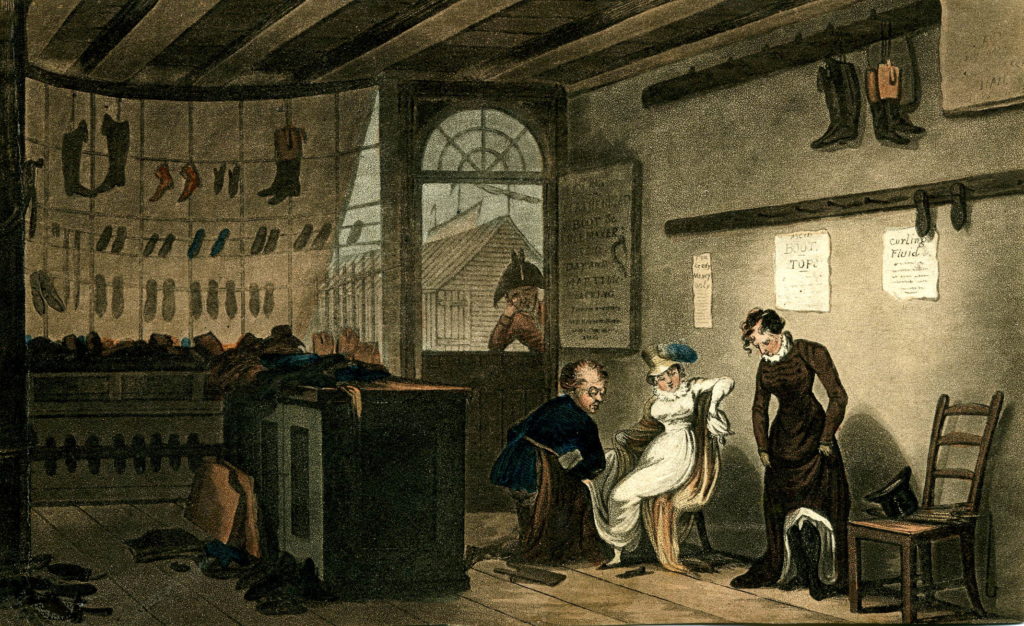
Question:
I’ve read that most tailors were men, that ladies got their footgear from these male tailors, and that the tailor himself tended to serve the client. So did a lady of the ton–did any lady–allow a male tailor to touch and handle her feet and ankles? Measure her, fit the slipper or boot? Did she actually show leg to a strange man? (Eg, how was she measured and fitted for half-boots and riding boots?) I have found only one image of a lady at a tailor’s, and he was definitely handling her foot while her companion (I assume, chaperone) stands nearby.
Shoes were available from both shoemakers and ready-made at shops or second hand stalls, depending on the class of the shopper.
For the gentry, shoemakers were the primary source of shoes. They would’ve accessed one maker of shoes or multiple shoemakers through shops.
Most shoes (including slippers) were made of leather (https://janeaustenslondon.com/tag/regency-london/page/3/), so shoemakers would have been skilled leatherworkers in which case they were called cordwainers. Cobblers mainly handled repairs. Other ladies shoes might be made of satin. I have included a couple of links before with wonderful descriptions of shoes and shoemakers for further reading.
In reviewing directories of tradesmen from the era, it would appear the bulk of shoemakers and cordwainers were men. However, because shoes were made of flexible (rather than stiff leather) and not meant to contour toes (see this excellent explanation about the lines of a Regency shoe: http://www.songsmyth.com/shoes.html), it seems feasible that there are a couple things at play in terms of shoes.
First, most shoes could probably be made from a tracing of a foot or having a foot placed in or handled by a measuring tool, and therefore would not require over handling of a lady. This is both because they were made (including boots) from flexible materials, and because there wasn’t a lot of contouring around a foot (meaning both shoes could fit on both feet).
Second, a shoemaker would probably be viewed as having a practical reason for touching a lady’s foot (like a doctor ascertaining injury). Naturally, any lady of quality would want a chaperone or lady’s maid to oversee the fittings, and its not hard to imagine some more elegant shoe seller shops having a lady on staff to assist. I also think where a lady to expose her foot for measurement and fitting, she would be skilled enough in lifting her skirts as to expose very little of her leg (at most an ankle) unless she was fitting a high boot (as depicted).
I haven’t been able to find any primary sources that talk about the process for measuring ladies for shoes, so much of the above is conjecture based on etiquette books, books on the trade, and pictures/paintings from the era. There is a later book (1865) on the art of shoemaking which is particularly instructive for the trade in the Victorian era.
I think its safe to say that yes, some male shoemakers or cordwainers may have touched a lady’s foot and seen a bit of leg in the process of measuring or fitting a shoe, however it was likely done discreetly, clinically, and without much embarrassment. Ladies from elevated stations would see the class barrier as enough of an invisible line to not regard the issue overmuch, and ladies of a similar station to the shoemaker would be more comfortable with certain types of practical/functional propriety breaking touching.
As always, I would love to hear what your research may have revealed about the above, so feel free to leave a comment below!
Appeared in The Tradesman, Volumne 5 (1810).
Read more:
Cordwainer, Shoemaker, Cobbler? Where would Georgian Londoners Buy Their Shoes?
https://janeaustensworld.wordpress.com/tag/regency-shoes/
https://janeaustensworld.wordpress.com/2011/03/09/regency-fashion-ladies-half-boots/
https://janeaustensworld.wordpress.com/tag/regency-shoemakers/









